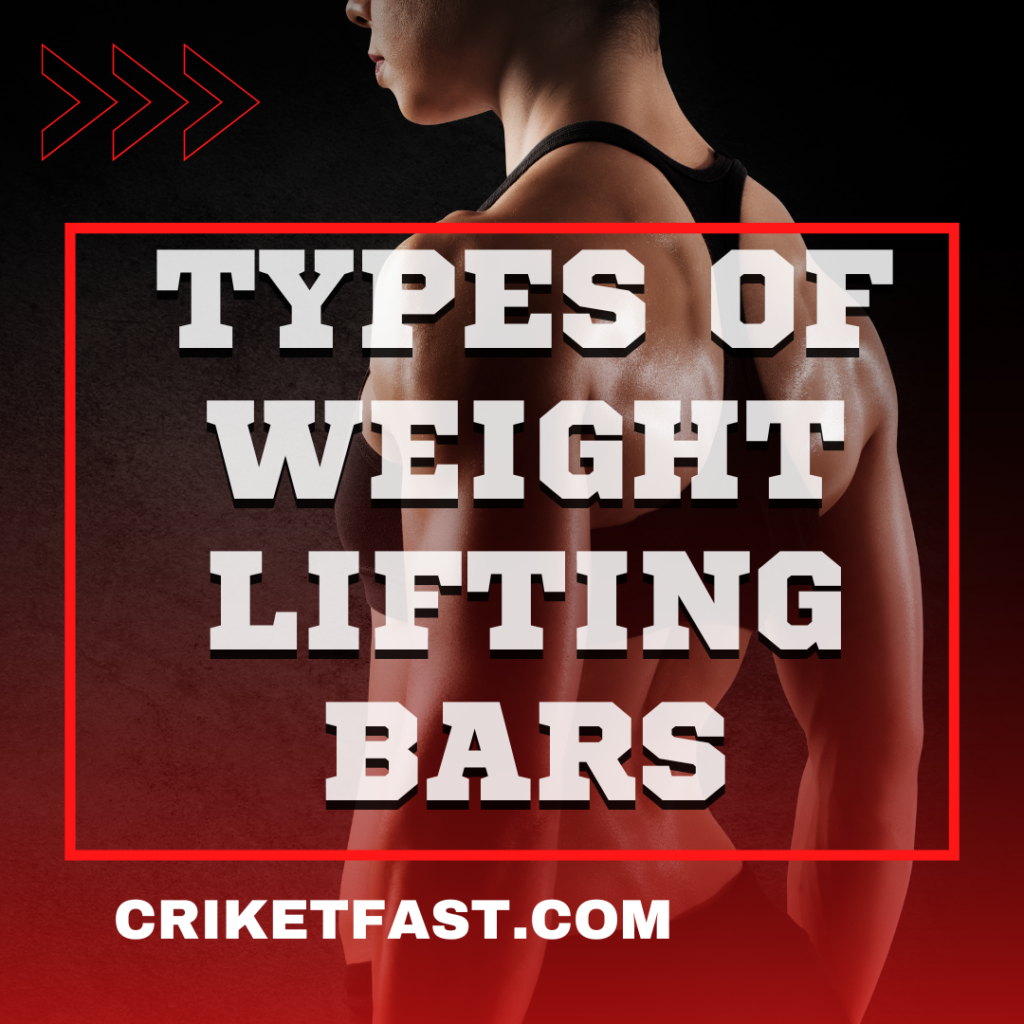The Best Way to Use Weightlifting Bar in GYM
A long, straight bar with weighted plates fastened to either end is called a weightlifting bar, or barbell. It can be used for a range of weightlifting exercises, such as rows, bench presses, deadlifts, and squats. The standard equipment for weightlifting competitions is Olympic barbells. They are 45 pounds in weight and 7 feet long. Usually measuring 6 feet in length and 35 pounds in weight, standard barbells are lighter and shorter.
The following are a few advantages of using a weightlifting bar:
- builds muscle mass and strength
- increases bone mass
- increases metabolism.
- improves physical fitness
- lowers the possibility of harm
It’s crucial to start light when weightlifting if you’ve never done it before and to gradually increase the weight as you gain strength. To prevent injury, you should also use proper form.
Weightlifting bars are vital equipment for strength training and have many advantages for general health and fitness.
They are vital to the following:
Gaining Strength and Muscle Mass: Barbell workouts efficiently work several muscle groups at once, promoting increased strength and muscle growth.
Enhancing Bone Density: Weight-bearing activities that promote bone formation, like deadlifts and squats, lower the risk of osteoporosis.
Enhancing Metabolism: Lifting weights during strength training raises the mass of your muscles, which raises your resting metabolic rate and helps you burn calories and control your weight.
Increasing Functional Fitness: Barbell exercises improve everyday movements, such as carrying groceries or climbing stairs.
Lowering Injury Risk: Stronger muscles and connective tissues result from proper form and technique when using barbells, which lowers the risk of injuries during daily activities.

The Basics of Weightlifting Bars
Barbells, sometimes referred to as weightlifting bars, are vital equipment for strength training because they provide a flexible and efficient means of increasing muscle mass, enhancing bone density, increasing metabolism, enhancing functional fitness, and lowering the risk of injury.
A versatile and necessary piece of equipment for strength training is the standard weightlifting bar, sometimes referred to as a bodybuilding bar or powerlifting bar. It is suitable for a variety of exercises and training levels because it is typically 6 feet long and weighs 45 pounds.
Important characteristics:
- Six feet (72 inches) in length
- 45 pounds (20.4 kilograms) in weight
- Dimensions: 28.5 mm in diameter
- One-inch sleeve diameter
- Knurling: An elevated grip pattern
- Capacity for Weight: 200–300 pounds (90–136 kg)
The following are some important lessons to remember:
- Select the best weightlifting bar based on your experience level and goals.
- To stop rust and corrosion, give your bar regular cleanings and maintenance.
- To keep your bar safe from harm, store it correctly.
- To prevent injuring yourself by overloading the bar, use the correct form and technique.
- You can get the most out of weightlifting bars and safely reach your fitness objectives by adhering to these guidelines.
Advantages of Using a Conventional Weightlifting Bar:
Versatility: Suitable for many exercises, such as bench presses, rows, overhead presses, squats, and deadlifts.
- Durability: Capable of withstanding large loads and frequent use.
- More reasonably priced than Olympic barbells.
- Accessibility: Generally available in fitness centers and gyms.
Standard Weightlifting Bar Types:
Chrome-plated: Most popular, long-lasting, and reasonably priced.
Black oxide: More costly, but offers superior grip and is resistant to rust and chipping.
Zinc plating: A little different in finish from black oxide, but similar in appearance.

Types of Weightlifting Bars
There are several types of weightlifting bars, each with its unique features and uses. Here are some of the most common types:
Standard Barbell: Usually measuring 6 feet in length and 45 pounds in weight, the standard barbell is the most popular type of weightlifting bar. It is an adaptable tool that can be used for many different exercises, such as deadlifts, bench presses, rows, and overhead presses.
Choosing the Right Weightlifting Bar for Your Goals
To choose the right weightlifting bar, consider your experience level, strength, and exercise types. Start with a standard barbell or EZ curl bar for beginners, and gradually move to an Olympic or specialized bar. Choose a weight appropriate for your strength level, considering your exercise types. Choose a bar with a comfortable knurling pattern for a secure grip. Finally, consider your budget, as weightlifting bars can range from $50 to over $500.
Setting fitness goals is crucial for success in your fitness journey. It helps you stay motivated, track your progress, and make adjustments to your workout routine. To identify your goals, consider your current fitness level and any limitations. Think about what you want to achieve, such as losing weight, gaining muscle, improving overall health, or training for a specific event. Set SMART goals, break them down into smaller steps, write them down, share them with friends and family, be patient, and celebrate your successes.
Examples of fitness goals include losing weight, gaining muscle, improving overall health, or training for a specific event. Develop a plan to achieve these goals, including a workout schedule, an appropriate exercise program, and a healthy diet. Find an activity that you enjoy, start slowly, increase intensity gradually, get enough rest, listen to your body, take breaks when needed, and ask for help from a personal trainer. Track your progress to stay motivated and make adjustments as needed.
Maintenance and Care
Maintaining your weightlifting bar is crucial for its longevity and safety. Regular cleaning, drying, and oiling are essential steps to prevent rust and corrosion. Dry the bar thoroughly with a clean towel and apply a light coat of 3-in-1 oil to maintain a smooth grip.
Store the bar in a dry, cool place away from direct sunlight. Inspect the bar for signs of damage and discontinue use if necessary. Preventive measures include avoiding dropping the bar, wiping off chalk and sweat after each use, storing the bar properly, using weightlifting belts or straps, and following proper form and technique. Proper maintenance is an investment in safety, performance, and equipment longevity.
To maintain a weightlifting bar, clean it regularly with mild detergent and warm water, dry it thoroughly, and apply a light coat of 3-in-1 oil to protect it from rust. Store it in a dry, cool place away from direct sunlight, avoid extreme temperatures and humidity, and inspect it regularly for signs of damage.
Avoid dropping the bar and wipe off chalk and sweat after each use. Store the bar properly, using a weightlifting rack or straps to support your back. Follow proper form and technique to avoid overloading the bar. These tips help extend the bar’s life and ensure safe working conditions.
Conclusion
For strength training, weightlifting bars are a need. They provide a flexible and efficient means of increasing muscle mass, improving bone density, increasing metabolism, enhancing functional fitness, and lowering the risk of injury. Weightlifting bars can last for many years and provide countless hours of safe and efficient exercise with the right upkeep.
Read More: The Best Ways That Outdoor Fitness Park Improves Your Skills
FAQs For Weightlifting Bars
Q: What is a weightlifting bar?
A: Weightlifting bars are long, straight bars with weighted plates attached to either end.
Q: What is another name for a weightlifting bar?
A: A barbell is also called a weightlifting bar.
Q: What types of exercises can be done with a weightlifting bar?
A: You can use a weightlifting bar for rows, bench presses, deadlifts, and squats.
Q: What are some common weight increments for barbell plates?
A: 25 lbs.
5 lbs.
10 lbs.
25 lbs.
45 lbs.
Common Weight Regimes for Barbell Plates
Q: Why are weightlifting bars typically straight and not curved?
A: Most weightlifting bars are straight. This allows the weight to be evenly distributed and allows the proper form to be maintained throughout the workout.
Q: Are there different types of weightlifting bars?
A: Olympic Bars, Powerlifting Bars, and Specialty Bars.


4 thoughts on “The Best Way to Use Weightlifting Bar in GYM”
Comments are closed.